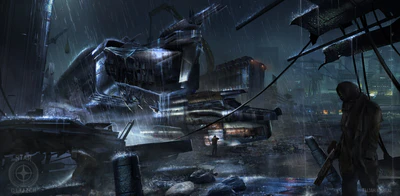“Magnus: On the Edge of the Unknown!” or so reads the local government’s standard travel brochure. In truth, the phrase better describes Magnus a century ago; recent decades have seen increasing settlement and overall civilization in a system that considers itself the unofficial capital of Human frontier culture.
First discovered in 2499, Magnus was a small, entirely undistinguished system: three planets orbiting a type K main sequence star. Dimmer than Earth’s own sun, Magnus did not have the pull to generate a system of outer planets or an extensive network of jump point tie-ins. Surveys have located no protoplanets, gas pockets or asteroid fields in the system’s environs; the area surrounding Magnus is the deepest, most desolate space imaginable. A single world, Magnus II, was identified as ideal for terraforming.
That process happened quickly. Magnus’ distance from well-traveled space plus the availability of heavy metals and the anticipated ease of terraforming Magnus II resulted in a military-commissioned closed-terraforming starting in 2533. By the late 26th century, Magnus had become a large-scale naval base and the source of a great deal of ship construction. This lasted approximately fifty years, until budget cutbacks and the desire to focus operations in other systems, like Kilian, lead to the large scale abandonment of Magnus.
For a time, Magnus II was a barren desert world — the effects of terraforming had not yet completely transformed the planet, and a ten-year period of extreme solar flares hampered its transition to a temperate world, increasing the decay of the UEE facilities and generally reducing overall interest in resettling Magnus. The result was an eerie, depopulated ghost world with declining structures full of refining and shipbuilding equipment considered too expensive to move elsewhere. During this period, the system’s population declined to less than 3,000, most of whom had no legal right to their encampments.
In 2751, the original military classification for the Magnus system expired and other colonists were technically allowed to move in. Seeing no practical use for the system, the UEE opted not to renew their lease claims for the sole inhabitable planet’s landmasses. The age of single-state colonization having long since ended, Magnus’ colonials were a ragtag group of outbackers, claim jumpers and an assortment of similar, less-savory types trying to escape their reputations on the core worlds. The result was a system with a reputation for a wild, anything-goes atmosphere, where Humans could live along the margins of the law. A culture supporting this system has since arisen organically, with a ‘kill-or-be-killed’ attitude that has developed into a strictly held frontier-style code of honor.
In recent years, Magnus II, Borea, has become more civilized, increasingly playing its reputation and fading ghost towns for tourist dollars. It’s still among the more dangerous Human-settled worlds: while the government has come to adhere to a more formal system, assassinations are still not uncommon. This culture is not onesided, however: for all the lawlessness, Magnus is seen as a place where anyone can start anew, a system that strongly believes in ignoring an individual’s past in favor of his or her potential. For this reason alone, settlement on Borea is increasing, year by year.
Magnus I is a chthonian planet, a former gas giant which has had its atmosphere fully separated by its proximity to the star’s sun. The result is a tightly compacted mass of rock rich in high value minerals. The UEE maintains full mining rights over Magnus I, and does not generally contract with outsiders for shipping or refinement. Owing to its cosmology, Magnus I is also a source of high grade diamonds, used both as gemstones and in factory operations. Again, the UEE moderates all sales and criminal elements have never established a significant foothold on Magnus I.

Borea is the terraformed center of the system. Classified as a near-Earth planet, Borea has a variety of climates and is generally ideal for Human settlement. The planet is dotted with dozens of centuries-old abandoned UEE naval facilities which are slowly fading into overgrowth.
Some have been settled by frontiersmen, while other prefab cities have sprung up elsewhere unrelated to the original settlement. Subsistence farms cover the planet’s temperate zones, most run by loners who have traveled to Magnus to escape contact with the rest of the Human race. The general feeling is of a world unnaturally stuck between then and now.
The capital of the world is Newcastle. A recent spacebased assassination attempt on the whole of the planet’s Governor’s Council has caused the government to redirect all in-bound traffic towards the industrial city of Odyssa, which can now be considered Magnus’ only starport. Odyssa, formerly a shipbuilding city before the UEE’s abandonment of Magnus, has been revitalized in recent years with the development of Drake Interplanetary. Vast tracts of empty warehouses and rusting construction yards have been modernized and returned to life building Cutlasses and Caterpillars. Gangs are a serious problem in the city, and squatters have claimed the rights to many former UEE facilities; the result is an interesting place to hunt for questionably legal ship repairs and upgrades.
Magnus III is a super Jupiter gas giant, a huge multi-colored sphere hanging at an extreme distance from Magnus’ sun. As it is not especially near any of the system’s jump points, Magnus III remains largely untapped as a refueling point. Persistent rumors claim that Magnus III’s LaGrange points are common meeting places for pirates, although this has never been confirmed. The lack of extraplanetary legal forces (and general cultural disinterest in punishing such crimes in the region) lend such rumors a significant air of believability. At the same time, Magnus III would be a notably out-of-the-way locale for anyone, especially the more significant pirate cartels.
